The Forum Hotel & Gardens
The Forum Hotel & Gardens
Experience a dynamic learning hub, collaboration and wellness on the vibrant Darden School Grounds:
- The Forum Hotel is an inviting boutique oasis featuring thoughtfully designed interiors and diverse food and beverage options. Indoor and outdoor event spaces provide captivating settings for connection and reflection.
- Nearby, the Tahija Arboretum and LaCross Botanical Gardens offer tranquility, beauty and wellness with a pond, a restored stream and inviting walking trails.
The Aspen Bar
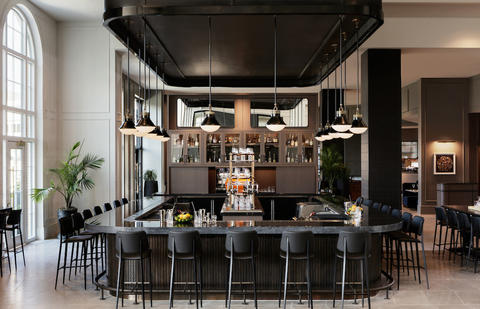
Gift of the Altec/Styslinger Foundation — The Forum Hotel's vibrant lobby bar.
Conference Center for Executive Education and Lifelong Learning

The Forum Hotel’s state-of-the-art conference center supports Darden’s mission to deliver world-class executive education and lifelong learning. Purpose-built for programs, seminars, and convenings, this dynamic space fosters collaboration, innovation, and leadership development. Naming the Conference Center offers transformational recognition at the intersection of education, business, and global impact.
Oak Board Room
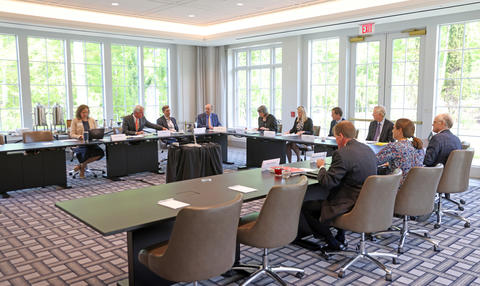
Gift of Robert J. Hugin (MBA '85) & Kathleen Hugin — A strategic meeting space for high-level discussions formally named the Hugin Family Executive Board Room.
L'Orangerie
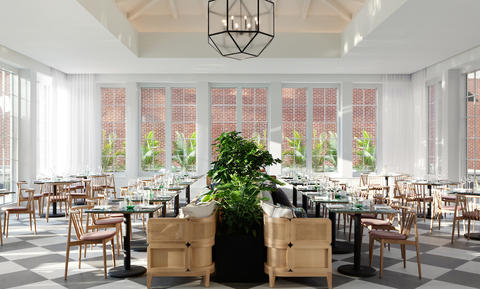
Gift of the Melville Foundation — An intimate and serene space adjacent to The Forum Hotel's main dining room, offering stunning garden views. Includes adjacent terrace.
The Agora

The heart of The Forum Hotel, The Agora is a soaring central atrium that welcomes guests with light, energy and connection. Framed by art, natural views and surrounding gathering spaces, it serves as a vibrant hub for conversation, relaxation and inspiration. Naming The Agora offers premier visibility in one of the hotel’s most iconic and architecturally striking locations.
The Grove Ballroom
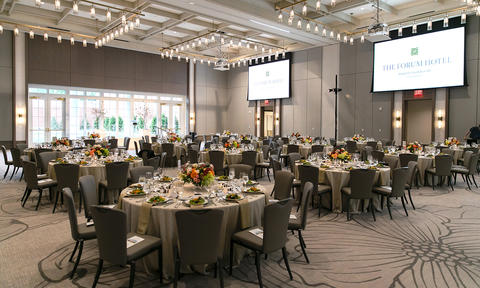
The signature event space at The Forum Hotel, The Grove Ballroom is a versatile venue accommodating up to 800 guests. Ideal for conferences, celebrations, and large gatherings, it offers a flexible layout, elegant design, and a seamless connection to adjacent pre-function and outdoor spaces. Naming The Grove Ballroom provides premier recognition in one of the hotel’s most distinguished and in-demand settings.
Sloney's Porch

Gift of the Class of 1993 in memory of Michael B. Slone (MBA '93) — An outdoor dining space.
The Forum Hotel Left Wing
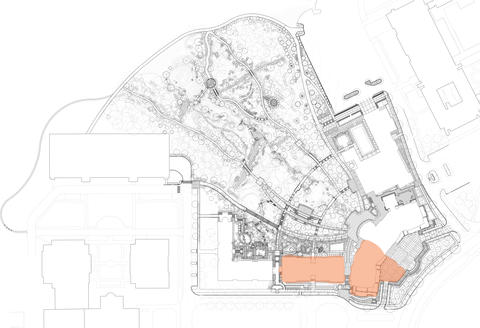
Comprising an entire wing of The Forum Hotel, this section includes guest rooms and key amenities that contribute to the hotel’s exceptional hospitality experience. Naming this prominent wing offers lasting visibility and a meaningful connection to the heart of the Darden Grounds.
The Washington Room
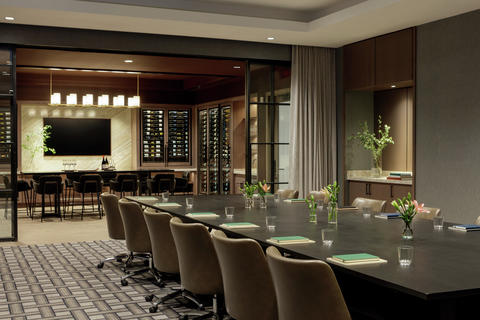
Gift of Adair Newhall (MBA '09) & Kathryn Newhall Family — General Washington was an American president, statesman, and military leader who became a legendary figure of American values. His selflessness, courage, and leadership are reminders of how best to live. May every Darden student be reminded of these qualities as they set their own path forward.
The Forum Hotel Right Wing
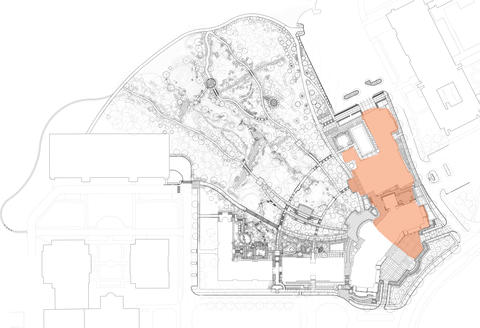
Comprising an entire wing of The Forum Hotel, this section includes guest rooms and key amenities that contribute to the hotel’s exceptional hospitality experience. Naming this prominent wing offers lasting visibility and a meaningful connection to the heart of the Darden Grounds.
The Grove Ballroom Terrace
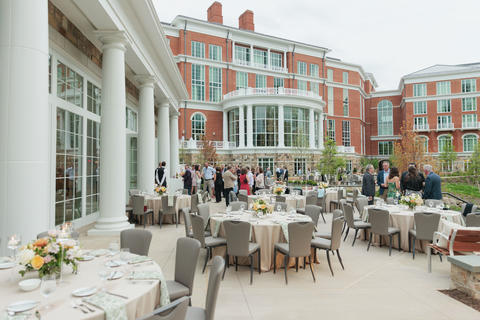
An elegant outdoor extension of The Grove Ballroom, the Terrace offers a seamless indoor-outdoor experience for receptions, cocktail hours, and breakout sessions. Overlooking the hotel’s landscaped grounds, this inviting space enhances events with fresh air, natural light, and refined ambiance. Naming the Grove Ballroom Terrace provides meaningful recognition in a distinctive setting that elevates every gathering.
The Bruner Case Study
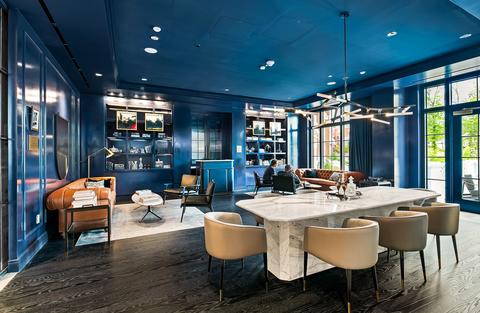
Gift of Darden alumni, colleagues and friends in honor of Robert F. Bruner: University Professor, Distinguished Professor of Business Administration, Dean Emeritus, Financial Economist, Author, Best-Selling Case Writer, Award-Winning Teacher and Member of the Darden Faculty, 1982-2023.
Check out this video tour of Bruner Case Study.
Socrates Classroom
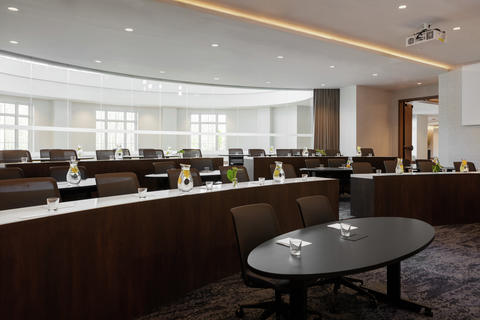
Gift of Steven C. Voorhees (MBA '80, Parent '14) & Celia H. Voorhees — The Socratic method has inspired the development of the case method at Darden and the transformational learning experience for thousands of Darden students and alumni.
Atrium Wing Lobby

Located just outside The Grove Ballroom, the Atrium Wing Lobby serves as a welcoming and comfortable gathering point for guests. Ideal for pre-function receptions, networking or informal conversation, this elegantly appointed space offers a natural flow into one of the hotel’s premier event venues. Naming the Atrium Wing Lobby provides prominent visibility in a high-traffic area central to the hotel’s event experience.
The Lyceum

The Lyceum is a versatile, flat-floor classroom designed for interactive learning, workshops, and executive sessions. With flexible seating and integrated technology, the space supports collaboration, dialogue, and idea exchange. Naming The Lyceum offers lasting recognition in a setting that reflects Darden’s commitment to dynamic teaching and lifelong education.
The Academy
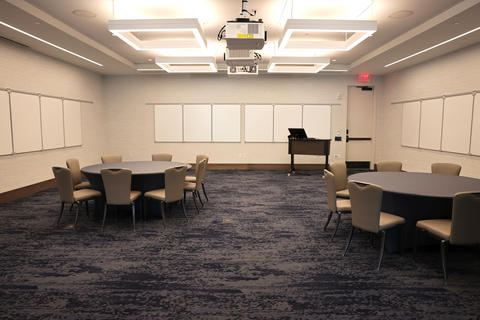
The Academy is a flexible, flat-floor classroom designed to support workshops, seminars and collaborative learning experiences. With modern technology and adaptable furnishings, it fosters engagement, creativity and connection among participants. Naming The Academy offers meaningful recognition in a space dedicated to education, innovation, and lifelong learning at the heart of the Darden experience.
C-Suite Terrace
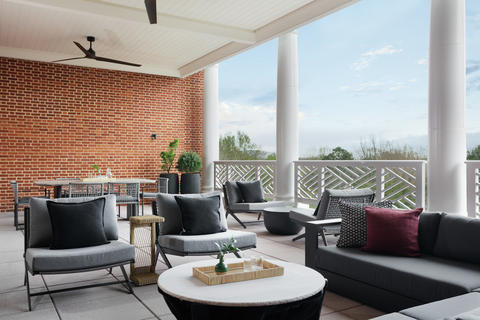
Gift of the Altec/Styslinger Foundation — A hospitality suite offering spectacular views.
Event Lawn
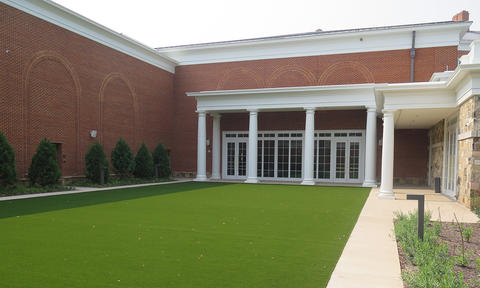
The Event Lawn is a premier outdoor venue at The Forum Hotel, accommodating up to 480 guests for weddings, receptions, dinners and large gatherings. Surrounded by the hotel’s botanical gardens and thoughtfully landscaped grounds, the space offers flexibility, beauty and a seamless connection to nature. Naming the Event Lawn provides high-profile recognition in one of the hotel’s most active and memorable gathering spaces.
Aspen Bar Terrace
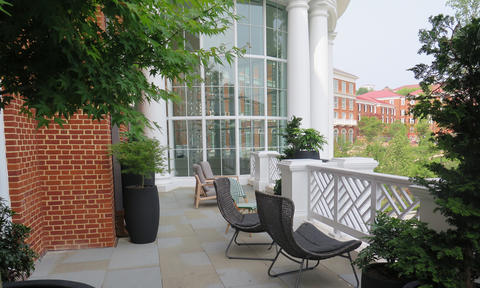
Gift of the Altec/Styslinger Foundation — An outdoor terrace with picturesque views.
The Connection Bridge

Gift of Steven C. Voorhees (MBA ’80, Parent ’14) & Celia Voorhees — The quality of our Darden experience is enhanced by the opportunities we have to connect with each other.
The Foyer

Serving as the grand entrance to The Forum Hotel, the Foyer offers a welcoming first impression for guests, alumni, and visitors. This elegantly designed space connects seamlessly to the central atrium and adjacent event areas, setting the tone for memorable experiences and meaningful gatherings. Naming the Foyer offers high visibility and lasting recognition in one of the hotel’s most frequented and architecturally striking spaces.
Casa '88

Gift of Martina Hund-Mejean (MBA '88) and Bruno J. Mejean — An intimate wine cellar housing a curated collection of fine wines.
Brielle DuFlon Art Installation

A dynamic centerpiece in The Forum Hotel’s central atrium, In Ancient Harmony: A Song of Virginia’s Native Flora by artist Brielle DuFlon celebrates the quiet beauty of the region’s plant life. Spanning 24 feet, the suspended installation features hand-printed acrylic tiles, each carved and block-printed by DuFlon to depict native species like dogwood, tulip tree, and mountain laurel. Gently turning in the air, the tiles create a sense of movement and light, offering a layered view into the adjacent botanical gardens. This work reflects Darden’s commitment to sustainability, regional identity, and the transformative power of art.
Hospitality Suite
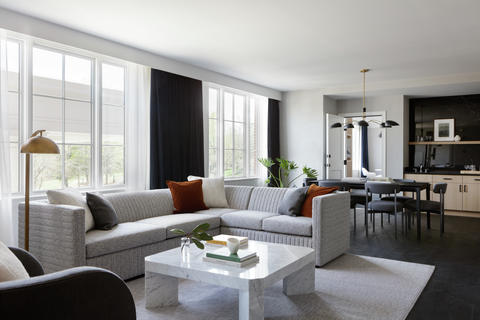
A versatile, well-appointed space located on the second floor of The Forum Hotel, ideal for intimate meetings, private gatherings, or small-scale events. Designed for flexibility and comfort, the suite offers a welcoming environment for productive conversations and memorable occasions.
Fireplace
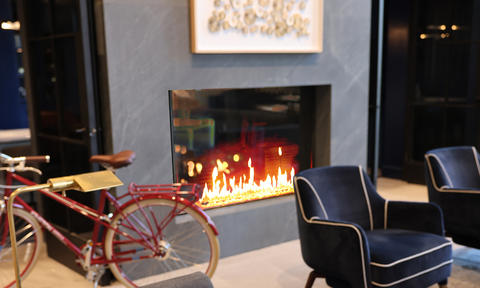
A striking architectural feature and warm gathering point, the see-through fireplace anchors the heart of The Forum Hotel — serving as a shared focal point between the lobby and the Bruner Case Study Room. Radiating comfort and connection, it invites informal conversation, moments of pause, and serendipitous exchange among students, faculty, alumni and guests. Naming the fireplace offers a unique opportunity to be part of the everyday magic that happens when people come together — around ideas, around warmth and around shared purpose.
Residential Wing Alcove Lounges (6)
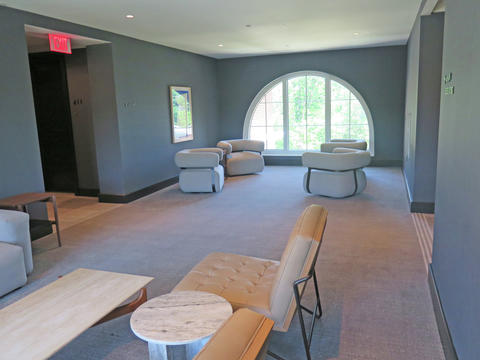
Nestled within the residential corridors of The Forum Hotel, each Alcove Lounge offers a quiet retreat for reflection, connection or casual conversation. These intimate spaces foster moments of rest and camaraderie for students, alumni and executive guests alike — between sessions, after travel or during a pause in a full day of learning. Naming an Alcove Lounge is an opportunity to create a welcoming space that supports the human side of transformational learning — rest, renewal and meaningful interaction.
6 AVAILABLE
Hotel Suites (4)
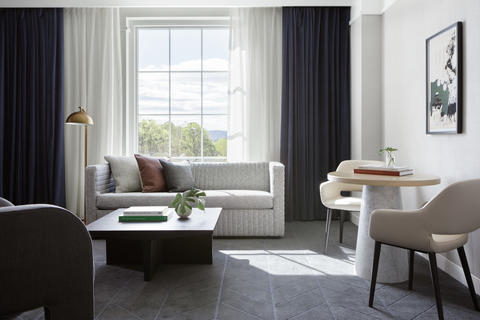
The Forum Hotel’s executive suites offer a refined, residential-style experience that blends comfort and elegance with the spirit of hospitality at the heart of the Darden community. Each suite provides a welcoming space for distinguished guests, speakers, alumni and executive participants, often serving as a home base for reflection, preparation and connection during visits. Naming a suite offers a meaningful opportunity to leave a lasting legacy within a space that hosts influential conversations and transformational moments.
There are 4 available.
Hotel Rooms (188)
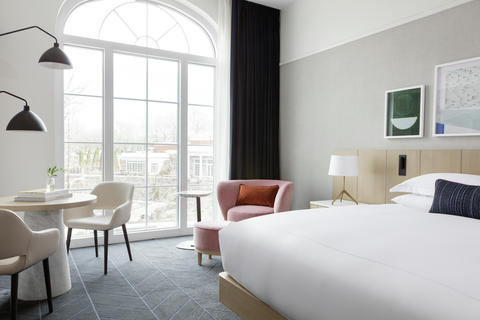
The Forum Hotel’s thoughtfully appointed guest rooms support Darden’s mission of lifelong learning by offering comfort and convenience to students, alumni, faculty and executive participants. These rooms are where visiting professionals rest between sessions, where lifelong learners begin and end their days, and where global guests experience Darden’s world-class hospitality. A room dedication is a lasting tribute, symbolizing your commitment to advancing education, community and leadership — one stay at a time.
188 AVAILABLE
Tahija Arboretum
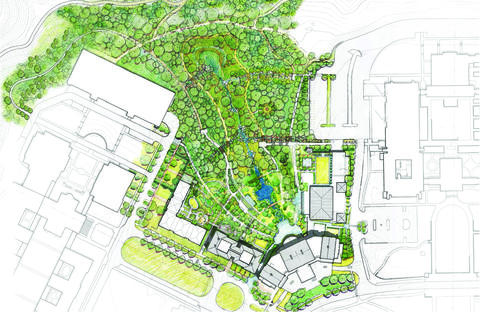
Gift of George S. Tahija (MBA ’86) & Laurel Claire Tahija — George S. Tahija is among Darden's most highly engaged international alumni. He has served as honorary chair of Darden’s Powered by Purpose capital campaign, on Darden's Global Advisory Council and on the Darden Board of Trustees. In 2021 he was the first international recipient of the Charles C. Abbott Award. Darden's highest honor bestowed upon alumni. In addition to supporting the formation of this Arboretum, his philanthropy has expanded Darden's global footprint and learning opportunities, increased scholarships for international students, contributed to faculty excellence, and provided important unrestricted support. In Indonesia, Tahija served as President Director of PT Austindo Nusantara Jaya Tok (ANJ) from 1986-2013 and, since then, has been a Member of the ANJ Board of Commissioners. He is a founding member and Trustee of the Tahija Foundation (1990), Asia Business Council (2002), Coral Triangle Center (2011), and Endeavor Indonesia (2013). Since 1988 Tahija has served the board of The Nature Conservancy in Indonesia and currently serves as the Co-Vice-Chair of The Nature Conservancy Asia Pacific Council.
LaCross Botanical Gardens
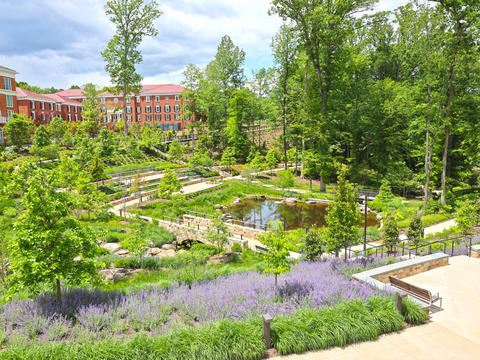
Gift of David M. LaCross (MBA’78) & Kathleen LaCross — A preeminent business leader and entrepreneur, Dave spent 10 years at Bank of America, where he undertook executive assignments around the world. He founded Risk Management Technologies (RMT) and pioneered the development of enterprise-wide interest and risk management software for large financial institutions. RMT was later acquired by the Fair Isaac Corporation (FICO). In 2014 he and his son Michael founded Morgan Territory Brewing in Tracy, California. Dave has served on the Darden School Foundation Board of Trustees, and in addition to supporting the formation of these Botanical Gardens, Dave and his wife Kathy’s transformational support has established the David M. LaCross Professorship that will evolve into the Dean’s Chair at Darden and will advance key priorities, including residential housing and a research center or initiative on artificial intelligence that will benefit the Darden community for generations.
Restored Stream
Dedication forthcoming — The Restored Stream is a central feature of the Tahija Arboretum & LaCross Botanical Gardens, showcasing the integration of sustainable design and ecological restoration. Once a stormwater runoff channel, the stream has been thoughtfully transformed into a functioning natural waterway that supports local biodiversity and improves water quality. Flowing gently through the gardens, it enhances the landscape’s beauty while demonstrating the power of regenerative landscape architecture. The stream not only creates a peaceful, sensory-rich environment for visitors but also plays a key role in the arboretum’s stormwater management system, connecting sustainability with serenity.
Pond
The Pond is a serene centerpiece of the Tahija Arboretum & LaCross Botanical Gardens, offering a reflective space where visitors can pause and take in the surrounding beauty. Designed to support biodiversity and complement the arboretum’s stormwater management system, the pond is both a habitat for native wildlife and a model of sustainable design. Framed by a rich palette of plantings and adjacent walking trails, the pond enhances the sensory experience of the gardens while underscoring Darden’s commitment to environmental stewardship and regenerative landscapes.
Camellia Promenade

Gift of The Altec/Styslinger Foundation — A communal space outside of The Forum Hotel.
The Class of 1987 Amphitheater & Outdoor Classroom

Gift of the Darden Class of 1987 — Dedicated to the Darden professors who changed our lives.
Witch Hazel Council Ring
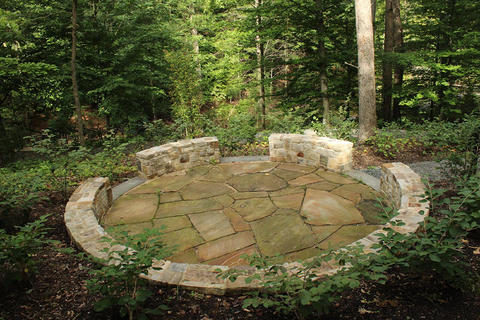
Dedication forthcoming — A Council Ring traditionally serves as a gathering place for meetings, discussions, and communal events. Symbolically circular, it represents equality and unity among participants. The Council Ring is surrounded by native Witch Hazel trees, which bloom during late fall and winter when most other plants are dormant. The presence of Witch Hazel signifies resilience and endurance, as its bright yellow or orange blossoms offer a burst of color and life during the colder months. These blossoms symbolize hope, transformation, and the cyclical nature of life.
Smith Alumni Gateway

An elegant entry from Duffy Boulevard into the gardens, the Smith Alumni Gateway connects academic and natural spaces. Framed by hydrangeas, this passage invites reflection and reinforces the lifelong bond between alumni and Darden.
Arrival Gardens, Allées and Upper Grounds Entrances
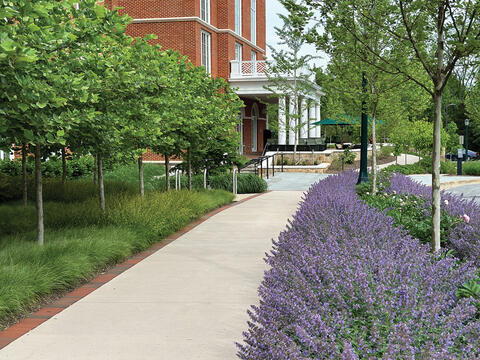
The Arrival Gardens, Allées, and Upper Grounds Entrances create a grand and inviting approach to the Tahija Arboretum & LaCross Botanical Gardens, welcoming visitors with thoughtfully designed landscapes, tree-lined pathways, and seasonal plantings. These entrances serve as key access points, offering a seamless transition from the Darden School and The Forum Hotel into the gardens. Designed to enhance the visitor experience, the allées provide structured walkways framed by carefully selected trees, guiding guests into the heart of the arboretum. These spaces reflect Darden’s commitment to sustainability and natural beauty, setting the stage for exploration, reflection, and engagement with the surrounding landscape.
Gateway and Promenade
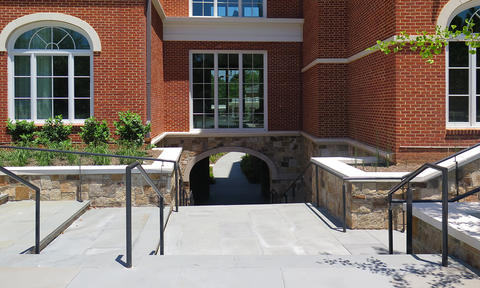
The Gateway and Promenade serves as a welcoming entrance to the Tahija Arboretum & LaCross Botanical Gardens, offering a seamless transition from The Forum Hotel and Duffy Boulevard into the natural beauty of the gardens. This thoughtfully designed passageway guides visitors through a curated landscape of seasonal plantings, inviting them to explore the arboretum’s tranquil paths and vibrant botanical collections. As a vital link between the Darden School, The Forum Hotel, and the gardens, the Gateway and Promenade reflects the spirit of connection, discovery, and sustainability that defines this remarkable space.
L'Orangerie Garden
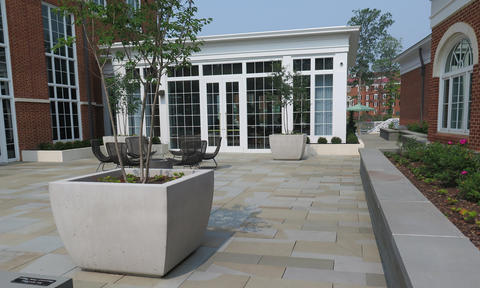
"L’Orangerie" originated in Europe during the 16th and 17th centuries when citrus fruit held significant value. Historically, an orangery referred to a building specifically designed for cultivating citrus trees and served as an esteemed showcase for nobility. In 18th century North America, the term took on a broader meaning, encompassing any enclosed spaces or garden rooms dedicated to plant cultivation, such as greenhouses or conservatories. Notably, Thomas Jefferson constructed a greenhouse at Monticello, stating, "... in fact, the Mimosa Nilotica and Orange are the only plants I have ever intended to cultivate in my greenhouse."
Benches (20)
Strategically placed throughout the Tahija Arboretum & LaCross Botanical Gardens, these beautifully crafted benches provide visitors with moments of rest, reflection, and appreciation for the surrounding landscape. Whether overlooking the pond, nestled along winding trails, or positioned near iconic garden features, each bench invites guests to pause and connect with nature. These benches also serve as meaningful dedications honoring donors, faculty, alumni, and loved ones who have made a lasting impact on the Darden community.
Japanese Garden
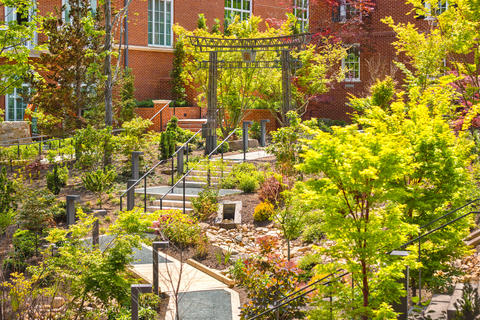
The spatial organization of the Japanese Garden was informed by the Japanese expression of “shin gyo so.” Each word describes a level of aesthetic formality that takes form within the garden. “Shin,” or “truth,” represents the most formal aesthetic that is expressed in the cut stone paths and straight lines between the Torii Gate and the entrance to Smith Hall. “Gyo,” or “going,” refers to a semi-formal aesthetic exhibited by the elliptical lawn room and surrounding fieldstones. “So,” or “grass,” addresses the most informal aesthetic and takes form in the meandering paths through the existing woodland beyond.
Lower Tahija Arboretum Trails
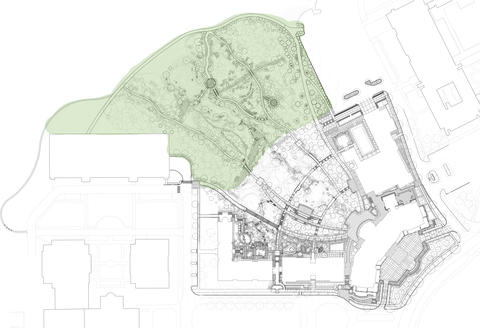
The Lower Tahija Arboretum Trails weave through the more naturalized areas of the gardens, offering a serene retreat into the diverse plant life and ecosystems that define the Tahija Arboretum & LaCross Botanical Gardens. These trails follow the contours of the landscape, leading visitors through woodland areas, riparian habitats, and native plant groupings, creating an experience that highlights the intersection of conservation and education. Designed to encourage exploration and appreciation of the gardens’ ecological diversity, the trails provide a peaceful, nature-immersed journey.
Edible Garden

Dedication forthcoming — The Prehistoric Plants Garden displays a selection of plant species that were present on Earth before humans. Specifically, the Ginkgo tree (Ginkgo biloba), Dawn Redwood (Metasequoia glyptostroboides) and Rough Horsetail (Equisetum hymale) found in the garden are known as "living fossils" because they are all relatively unchanged from the earliest known records of the species. Most scientists regard the Ginkgo tree as the only known living tree that co-existed with dinosaurs up to 200 million years ago, with some speculating that dinosaurs likely ate the tree's distinctly odorous fruit.
Viburnum Garden

Viburnums are a large group of flowering tree and shrub species in the Adoxacee, or Moschatel, plant family. Almost all viburnums display composite white flowers, which are formed by hundreds of individual florets. Depending on the species, these composite flowers can appear as umbels, a flat curved flower, or round (like a snowball). Most viburnums also produce red, blue or black drupes, which are fleshy fruits with a hard single seed at the center. In the winter, drupes are a source of visual interest in the landscape as well as an important food source for birds and other small animals.
Thomas Jefferson Garden

Gift of Donald E. Morel Jr., Ph.D. (TEP’97) & Lauren Morel — The Thomas Jefferson Garden displays some of the plants documented by Meriwether Lewis and William Clark during the Corps of Discovery expedition (1804-1806) at the request of then President Jefferson. On August 2, 1805, Lewis described what is thought to be the Saskatoon Serviceberry (Amelanchier alnifolia) when he wrote, “The service berry grows on a smaller bush and differs from ours only in colour and the superior excellence of its flavor and size; it is of a deep purple.”
Prehistoric Plants Garden
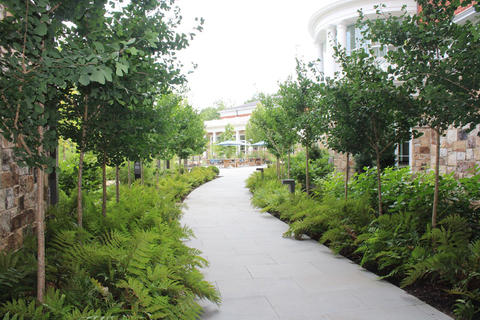
The Prehistoric Plants Garden displays a selection of plant species that were present on Earth before humans. Specifically, the Ginkgo tree (Ginkgo biloba), Dawn Redwood (Metasequoia glyptostroboides) and Rough Horsetail (Equisetum hymale) found in the garden are known as "living fossils" because they are all relatively unchanged from the earliest known records of the species. Most scientists regard the Ginkgo tree as the only known living tree that co-existed with dinosaurs up to 200 million years ago, with some speculating that dinosaurs likely ate the tree's distinctly odorous fruit.
Chinese Garden
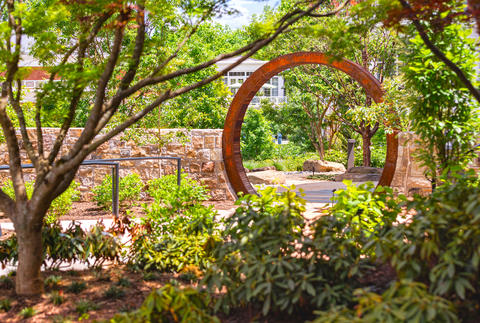
Dedication forthcoming — The design of the Chinese Garden was inspired by the experience of viewing Chinese scroll art. It is an episodic and anticipatory experience that reveals discrete poetic moments in the garden rather than grand views. The Chinese Garden encourages visitors to meander slowly as emblematic garden elements such as the moon gate, the dry stream bed representing water ("Yin" and boulders representing mountains ("Yang"), and specimen trees, such as Paperbark Maple (Acer griseum), emerge during their stroll.
International Garden

The International Garden is composed of ornamental plants originating from Asia, Europe and North America. The selected species are found in gardens and streetscapes across the world and are familiar to both domestic and international travelers. Some of the tree species found in the International Garden such as European Beech (Fagus sylvatica), have native counterparts American Beech (Fagus grandifolia) planted elsewhere in the Arboretum.
Magnolia Garden

The Magnolia Garden showcases Magnolia trees found in the Piedmont region. Members of the Magnoliaceae family are recognized by their large and fragrant flowers present in the spring and summer, as well as their fruits with “arils,” a bright red outer layer that protects the seeds in late summer and early fall. Magnolias found in undeveloped areas, including Cucumber Magnolia (Magnolia acuminata) and Bigleaf Magnolia (Magnolia macrophylla), are most often found along the banks of streams and rivers. Other magnolias, including Southern Magnolia (Magnolia grandiflora) and Sweetbay Magnolia (Magnolia virginiana) are frequently encountered in garden settings across the Southeastern United States.
Spicebush Bramble
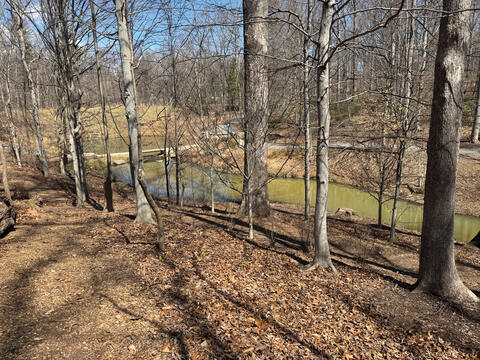
Spicebush (Lindera benzoin) is usually found in the shady understory of our native Virginia woodlands but can also tolerate full sun. The common name refers to the sweet, spicy, lemony fragrance of the stems, leaves and fruits. Spicebush is deer-resistant with early-season nectar for butterflies and bright red berries for migratory birds. The Spicebush Swallowtail lays eggs on the plant, signaling the symbiotic relationship between our native plants and migratory birds.
Connection Bridge

Gift of Steven C. Voorhees (MBA ’80, Parent ’14) & Celia Voorhees — The quality of our Darden experience is enhanced by the opportunities we have to connect with each other.
Upper Tahija Arboretum Trails
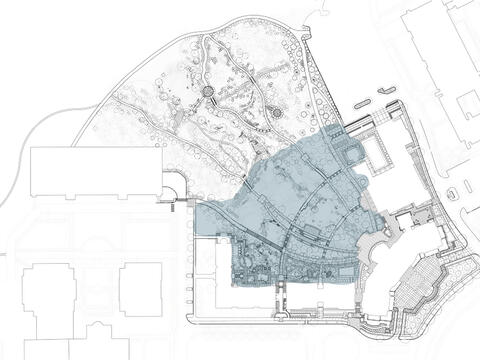
The Upper Tahija Arboretum Trails wind through a thoughtfully curated landscape of native and ornamental plantings, offering visitors an immersive experience in the beauty and biodiversity of the gardens. These trails provide an inviting space for reflection, education and connection with nature, featuring gently sloping pathways and shaded walkways.
Lower Foot Bridge
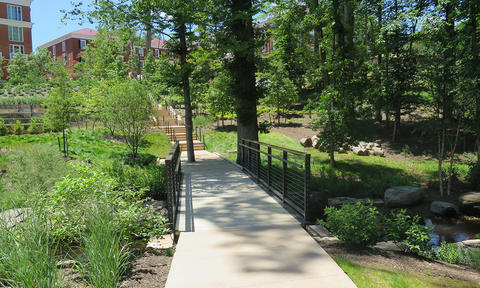
The Lower Foot Bridge provides a vital connection within the Tahija Arboretum & LaCross Botanical Gardens, allowing visitors to traverse the natural landscape while enjoying scenic views of the surrounding flora. Designed to blend seamlessly with its environment, the bridge enhances accessibility to the lower gardens, offering a quiet passage over the restored stream and linking key garden spaces. Whether used as a tranquil resting point or a pathway for exploration, the Lower Foot Bridge enriches the visitor experience by fostering a deeper connection with nature.
Carl Mason Franklin Footbridge
Gift of Morris S. Smith Foundation and trustees Sterling, Larry and Mei Franklin — In 1946, Carl Franklin, age 35, came to the UVA Law School on the GI Bill. He was first in his class for both years of the then two-year law program. Declining an offer to clerk at the United States Supreme Court, he went into academia and became an influential figure in law education nationwide. He loved education, carning six degrees: BA, Accounting, U. Washington (1931); MA, Economics, Stanford (1935); MA, Higher Education Administration, Columbia (1939); MBA, Harvard (1940); JD in law, UVA (1948); and JSD (Doctor of Juridical Science) in law, Yale (1956). For his 50th UVA Law Class Reunion, he endowed a Scholarship Fund and a Prize Fund to provide an annual Franklin Prize for the UVA Law student with the highest first-year grade point average. As a Trustee of several charitable foundations, he gifted millions of dollars to universities and other charities. He was truly a great man: smart, thoughtful, kind, helpful, and generous.
Spring Ephemeral Walk
Spring ephemerals are perennial woodland plants that emerge in late winter and spring to take advantage of the sunlight that penetrates through the bare branches of the trees to the forest floor. These early perennials provide nectar and pollen for native insects, and they help to stabilize steep slopes to prevent erosion. Species highlighted in this garden include Lily of the Valley (Convallaria majalis), Virginia Bluebells (Mertensia virginica) and White Trillium (Trillium grandiflorum).
Wooden Footpaths
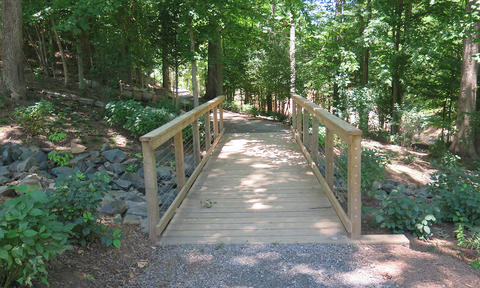
Gift of The Executive Program Class of 2022 — The “Tell Me More” Walkway.
Azalea, Kalmia and Rhododendron Knoll

Azaleas, Mountain Laurels, and Rhododendrons are all members of the botanical family Ericaceae and share some similarities in terms of appearance and growing conditions. Plants in the Ericaceae family are associated with acidic soils and thrive in habitats such as heathlands, moorlands, bogs, and coniferous forests. Ericaceous plants often form symbiotic relationships with certain fungi, forming mycorrhizal associations. Before the construction of the Inn, Mountain Laurel (Kalmia latifolia), Blueberries (Vaccinium), Sassafras (Sassafras albidum), and White Oak (Quercus alba) naturally germinated on the site.
Fern Glade

Ferns have a long evolutionary history with fossil evidence dating back over 360 million years. These ancient plants thrived without the need for flowers or seeds. Instead, ferns reproduce through spores, which are tiny, dust-like structures found on the undersides of their leaves. Belonging to a diverse group of plants called Pteridophytes, ferns encompass an impressive array of approximately 12,000 known species worldwide. Prior to the construction of the Inn, a mass of ferns was found in this area. Today, many of those same species, including Cinnamon Fern (Osmunda cinnamomea), Sensitive Fern (Onoclea sensibilis), and Marginal Wood Fern (Dryopteris marginalis), are planted here.
Sassafras Hill
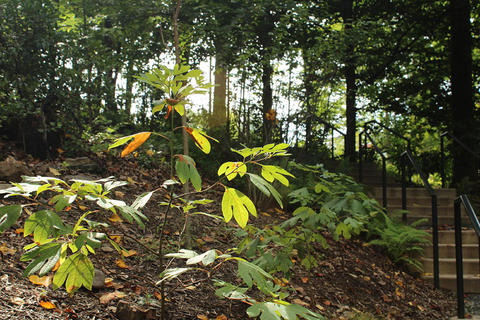
Sassafras (Sassafras albidum) is a native deciduous tree known for its brilliant display of autumn foliage and aromatic qualities. Although they can reach heights of 60 feet, Sassafras trees tend to grow as understory trees in Virginia. Sassafras leaves are unusual, as they vary on the same tree from oval to three-lobed mitten-shaped. The root of the plant was originally used in a beverage similar to root beer that has since been discontinued due to health concerns.
Conifer Walk
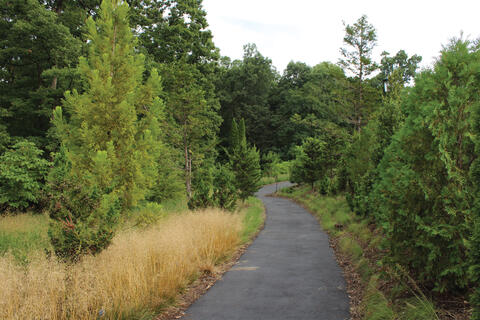
Derived from the Latin word meaning "the one that bears cones," the term "conifer" captures the essence of these remarkable trees. Conifer is a combination of two words: "conus," which refers to "cone” and "ferre" which means “to bear.” Conifers, with their unique needle-like or scale-like leaves, are often recognized as evergreen trees, maintaining their green foliage throughout the winter season. This general classification encompasses a diverse array of evergreen tree species, including Firs, Cedars, Spruces, Pines, Yews, Arborvitae, and Hemlocks.
Beech Promenade

Beech hedges originated from ancient pruning traditions in England. They were valued for practical and aesthetic purposes, serving as boundaries, providing privacy and acting as windbreaks. In this garden you can observe the subtle distinctions between the American and European Beech. The American Beech features smaller nuts and larger leaves while the European Beech bears larger nuts and shorter leaves.
Tulip Poplar Thicket
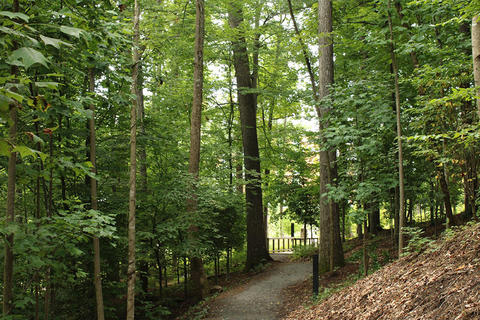
The Tulip Poplar (Liriodendron tulipifera) is known for its distinctive tulip-shaped flowers and yellow fall foliage. This native tree offers valuable habitat for wildlife. The dense foliage and abundant branches provide cover and nesting sites, the nectar-rich flowers attract pollinators like bees and butterflies, and the seeds are a food source for various birds and small mammals. Tulip poplar thickets often represent an early successional stage of the local Piedmont forest. They serve as pioneer tree species helping to stabilize the soil and create suitable conditions for the establishment of other plants. The Tulip Poplar was one of Thomas Jefferson’s favorite trees. He referred to it as “The Juno of our grove.”
| Space | Status | Cost |
|---|---|---|
| The Forum Hotel and Conference Center | ||
| Featured Spaces | ||
| The Aspen Bar | Reserved | $5,000,000 |
| Conference Center for Executive Education and Lifelong Learning | Available | $5,000,000 |
| Oak Board Room | Reserved | $3,000,000 |
| L'Orangerie | Reserved | $2,500,000 |
| The Agora | Available | $2,000,000 |
| The Grove Ballroom | Available | $2,000,000 |
| Sloney's Porch | Reserved | $1,000,000 |
| The Forum Hotel Left Wing | Available | $500,000 |
| The Washington Room | Reserved | $500,000 |
| The Forum Hotel Right Wing | Available | $500,000 |
| The Grove Ballroom Terrace | Available | $200,000 |
| Academic Spaces | ||
| The Bruner Case Study | Reserved | $1,000,000 |
| Socrates Classroom | Reserved | $750,000 |
| Atrium Wing Lobby | Available | $500,000 |
| The Lyceum | Available | $500,000 |
| The Academy | Available | $500,000 |
| Outdoor Spaces | ||
| C-Suite Terrace | Reserved | $1,000,000 |
| Event and Meeting Spaces | ||
| Event Lawn | Available | $1,000,000 |
| Aspen Bar Terrace | Reserved | $200,000 |
| Arrival Points | ||
| The Connection Bridge | Reserved | $500,000 |
| The Foyer | Available | $500,000 |
| Hospitality | ||
| Casa '88 | Reserved | $500,000 |
| Brielle DuFlon Art Installation | Available | $250,000 |
| Hospitality Suite | Available | $250,000 |
| Fireplace | Available | $100,000 |
| Residential Wing Alcove Lounges (6) | Available | $75,000 |
| Guest Rooms and Suites | ||
| Hotel Suites (4) | Available | $200,000 |
| Hotel Rooms (188) | Available | $25,000 |
| Tahija Arboretum and LaCross Botanical Gardens | ||
| Featured Spaces | ||
| Tahija Arboretum | Reserved | $5,000,000 |
| LaCross Botanical Gardens | Reserved | $5,000,000 |
| Aquatic Oases | ||
| Restored Stream | Reserved | $750,000 |
| Pond | Available | $750,000 |
| Communal Spaces | ||
| Camellia Promenade | Reserved | $750,000 |
| The Class of 1987 Amphitheater & Outdoor Classroom | Reserved | $500,000 |
| Witch Hazel Council Ring | Reserved | $250,000 |
| Arrival Points | ||
| Smith Alumni Gateway | Available | $1,000,000 |
| Arrival Gardens, Allées and Upper Grounds Entrances | Available | $750,000 |
| Gateway and Promenade | Available | $500,000 |
| L'Orangerie Garden | Available | $250,000 |
| Benches (20) | Reserved | $10,000 |
| Varietal Thematic Gardens | ||
| Japanese Garden | Reserved | $500,000 |
| Lower Tahija Arboretum Trails | Available | $500,000 |
| Edible Garden | Reserved | $250,000 |
| Viburnum Garden | Available | $250,000 |
| Thomas Jefferson Garden | Reserved | $250,000 |
| Prehistoric Plants Garden | Available | $250,000 |
| Chinese Garden | Reserved | $250,000 |
| International Garden | Available | $250,000 |
| Magnolia Garden | Available | $250,000 |
| Spicebush Bramble | Available | $250,000 |
| Walks and Trails | ||
| Connection Bridge | Reserved | $500,000 |
| Upper Tahija Arboretum Trails | Available | $250,000 |
| Lower Foot Bridge | Available | $250,000 |
| Carl Mason Franklin Footbridge | Reserved | $250,000 |
| Spring Ephemeral Walk | Available | $150,000 |
| Wooden Footpaths | Reserved | $10,000 |
| Woodlands and Clearings | ||
| Azalea, Kalmia and Rhododendron Knoll | Available | $250,000 |
| Fern Glade | Available | $250,000 |
| Sassafras Hill | Available | $250,000 |
| Conifer Walk | Available | $250,000 |
| Beech Promenade | Available | $150,000 |
| Tulip Poplar Thicket | Available | $150,000 |
*All naming and naming levels subject to UVA approval
Plant a Tree at Darden
Join us in enhancing the beauty of the Tahija Arboretum and LaCross Botanical Gardens that encircle the Forum Hotel with the addition of 1,300 trees including dogwoods and eastern redbuds. At a contribution of $10,000, you can have the unique opportunity to name a tree. It's a perfect way to honor your graduating class, favorite faculty member, fellow student, a loved one or even an organization with a dedicated grove of trees.
- Camellia Promenade
- The Forum Amphitheater
- Event Lawn
- Lower Foot Bridge
- The Connection Bridge
- Alumni Gateway
- Gateway and Promenade
- Law Gateway
- The Carl Mason Franklin Footbridge
- The Grove Ballroom Terrace
- Japanese Garden
- Chinese Garden
- Viburnum Garden
- Prehistoric Plants Garden
- International Edibles Garden
- Magnolia Garden
- Thomas Jefferson Garden
- Pond
- L’Orangerie Garden
- International Garden
- Riparian Garden
- Spring Ephemeral Walk
- Tulip Poplar Thicket
- Stream
- Beech Grove
- Fern Glade
- Azalea, Kalmia and Rhododendron Knoll
- Spicebush Bramble
- Conifer Walk
- Council Ring
- Sassafras Hill